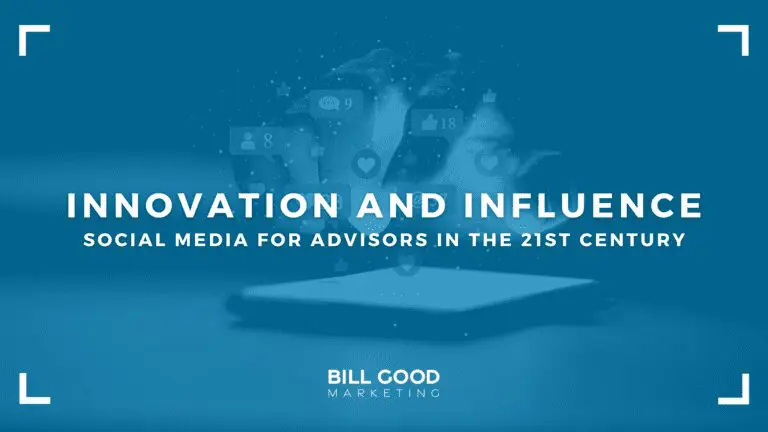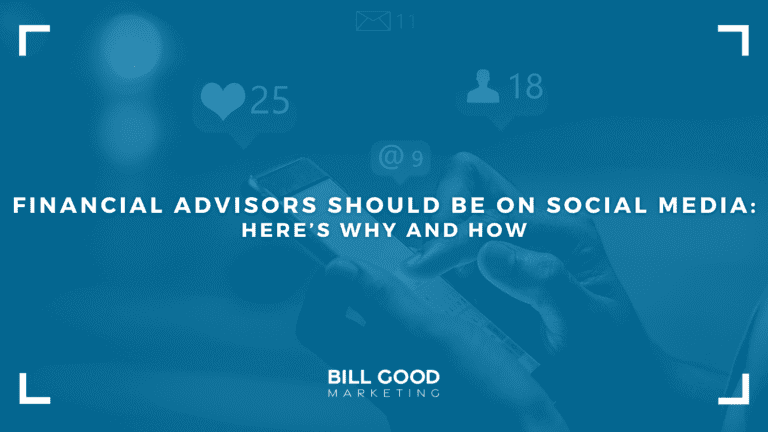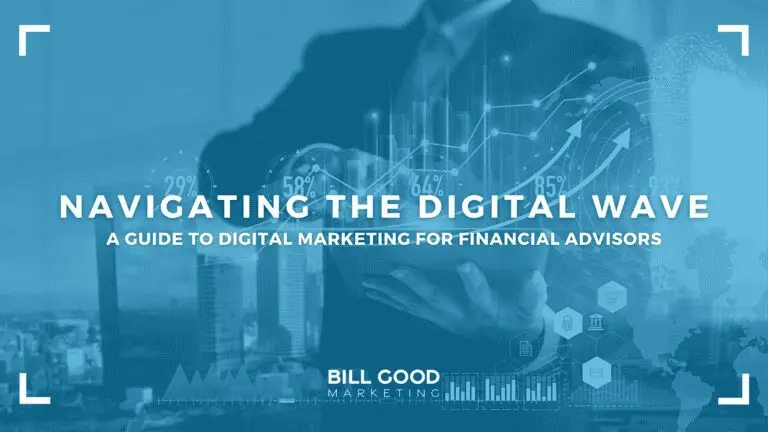In the ever-evolving landscape of the financial services industry, one truth has become self-evident: social media is not just a playground for personal exchanges anymore—it’s a pivotal battleground for the hearts and minds of prospective clients. As financial advisors, it’s time to embrace this digital shift with open arms and astute strategies.
Why, you ask? Because LinkedIn and its kin are no longer optional sidelines; they are central to how younger, tech-savvy investors are making critical decisions. These platforms are where your next big client could be waiting, scrolling for a financial guru who stands out not just for their acumen but also for their engaging online presence.
Gone are the days when a firm handshake and a business card sufficed. Today, it’s about crafting a digital handshake that’s just as firm through your social media strategy. This is where millennials are searching, not in the yellow pages or a referral, but in the vast and immediate world of hashtags and news feeds. According to a survey done by Forbes Advisor 79% of Millennials and Gen Z are getting financial advice from social media.
So, let’s dive in. Whether you’re looking to refine your digital footprint or just starting to leave your mark online, our guide is here to walk you through the essentials of social media mastery. From building a robust LinkedIn profile to understanding the intricacies of what makes a post share-worthy, we’ve got you covered.
Are you ready to transform your social media from a mere presence to a potent tool for growth? Let’s navigate this digital journey together and set your practice on a path to success that resonates with the modern investor.
The Digital Marketing Shift for Financial Advisors
As we pivot to the first cornerstone of our digital strategy, let’s lay down the numbers that paint the undeniable shift in the financial advisory sector.
Picture this: a burgeoning group of potential clients, all under 45, are now turning their gazes to online platforms for their financial planning needs. Gone are the days of leafing through local directories or solely relying on family recommendations. Today, these digital natives start their wealth management journey with a few keystrokes and clicks.
According to a study done by eMoney in 2020,
“42% of consumers start their search for a financial advisor on search engines like Google. This was higher than the number of people who said they start by asking friends or family (32%). What’s more, 44% of consumers in the same study said they get or search for financial advice on digital media.”
The narrative has changed, and it’s been recorded in the very metrics we scrutinize. These figures aren’t just digits; they are a testament to a new era of client engagement and acquisition. They tell us that a significant portion of your target audience is scrolling through social media right now, looking for investment advice that speaks to them, that understands their aspirations, and that guides them towards financial empowerment.
So, what does this mean for you, the financial advisor? It means that your digital marketing efforts need to be as savvy and sophisticated as the clients you aim to serve. It means that LinkedIn isn’t just a network; it’s a lifeline to connect with those who will soon form the backbone of your clientele. It’s also a signal that platforms like TikTok, often stereotyped as the realm for teeny-boppers and Gen Z, are emerging as genuine places for financial education and discussion. (According to Putnam’s Social Advisor Survey, “Those using TikTok for business … report average assets gained attributable to their use of social media at $6.9M.”)
Now, that’s not to say that this repeatable for all advisors or that every advisor should be on TikTok.
But what’s important is that here lies the opportunity to educate and to be seen regardless of the platform you decide to utilize. The content you share, the insights you offer, and the stories you tell can all serve as powerful touchpoints.
Whether it’s a blog post that demystifies the latest market trends or an infographic that simplifies complex financial concepts, each piece of content you distribute contributes to your online persona – one that should resonate with both the intelligence of a seasoned investor and the relatability of a trusted financial advisor.
It’s about striking a balance between being informative and being accessible. Your social media footprint has the power to not only showcase your expertise but also to reflect your understanding of where the industry is headed. In other words, it will show your target market that you are uniquely qualified to be their financial guide.
With digital marketing now integral to the financial services industry, it’s your move to step into the role of the modern advisor – one who embraces technology, engages with it meaningfully, and uses it to craft a narrative of trust, credibility, and foresight.
Social Media Marketing in Advisor-Client Relations
Let’s address a big question: Why is social media becoming so crucial for strong advisor-client relationships? It’s more than just being online. It’s about truly grasping how social media creates special ways for people to interact.
Consider the journey of today’s younger investor – it often starts with a Google search and a scroll through social media feeds. This is where they encounter your brand for the first time. It’s where they’ll read testimonials from your clients, witness your interactions with followers, and start to form an impression of you as a financial professional. Here, your online persona needs to do more than just exist; it needs to communicate, engage, and, most importantly, solve problems.
Addressing pain points through social media isn’t just about acknowledging them; it’s about presenting yourself as the solution. Through educational webinars, insightful articles, and timely advice, you become a beacon of knowledge in a sea of information. Your marketing efforts on these channels are not just posts; they are the building blocks of your digital reputation.
Each tweet, post, or update is a chance to reinforce your position as a thought leader. But with great power comes great responsibility – and that’s where FINRA’s rules on social media come in.
Navigating compliance while being creative might seem daunting, but it’s all part of the marketing strategy for today’s financial advisors. It’s about crafting messages that resonate, without crossing lines that could land you in the doghouse with FINRA.
Your social media content strategy should be a blend of professionalism and personality. Consider the marketing channels at your disposal – each serves a different purpose. LinkedIn, for example, is the perfect platform for whitepapers and in-depth discussions, while Instagram can showcase the more personal side of your advisory business, connecting over shared values and experiences.
But it’s not just about broadcasting your message; it’s about sparking conversations. Engagement is the currency of social media, and it’s a two-way street. It’s not enough to post and forget; you need to be active, responsive, and genuinely interested in what your audience has to say.
Ask questions, run polls, and encourage your subscribers to share their thoughts. This interaction is what transforms followers into leads and, eventually, into new clients.
And let’s not forget about the power of storytelling. Social media is the perfect canvas to paint the picture of your client’s journey to financial success, with you as their guide. Share the milestones and the successes, and when appropriate, the lessons learned from challenges. This isn’t just content; it’s your narrative unfolding in real-time, one that aligns with the aspirations and concerns of your prospective clients.
Building an Impactful Online Presence: Crafting Engaging Social Media Posts
Let’s dive into the first actionable step: cultivating a presence that truly stands out in the crowded digital marketplace. For financial advisors and CFP’s, building online brand awareness is more than just a fancy term; it’s about carving out a digital niche that aligns with your professional identity and values.
Your social media posts are the digital equivalent of a firm handshake – they should be strong, confident, and reassuring. But how do you ensure they echo in the minds of your target audience?
By delivering content that’s not only frequent but also packed with genuine value. This isn’t about pushing out a sales pitch; it’s about becoming the go-to source for insights on financial planning and the trusted voice in a sea of online noise.
Consider the timing and the platforms you choose – the ‘where’ and ‘when’ are just as crucial as the ‘what’. LinkedIn could be your powerhouse for sharing thought leadership articles, while Instagram stories can give a sneak peek into your daily professional life, building a relatable brand.
And let’s not forget TikTok, which might just be the unexpected ace in your sleeve for connecting with the up-and-coming generation of investors.
Remember, it’s not just about quantity; the quality of your content is what will keep you top-of-mind. Your aim should be to provide a consistent stream of social media posts that invite sharing and discussion. It’s about sparking curiosity and providing actionable insights that your audience can apply to their financial journeys. The key here is differentiation.
- What makes your practice unique?
- Is it your specialized knowledge in a certain area of financial planning?
- Or perhaps your innovative approach to investment strategy?
Use your social media presence to highlight these unique selling points, making it clear why a prospective client should choose you over the competition.
But awareness is only the first step. It’s what you build upon this foundation that truly counts. As we progress to the next phase, remember that awareness is the spark – engagement is the flame that keeps the relationship with your audience burning.
Engaging with the Right Audience via Effective Social Media Marketing
Moving from awareness to engagement is like going from a nod of acknowledgment to an in-depth conversation. Engagement on social media for financial advisors isn’t just about likes and shares; it’s about forging a connection that could very well lead to the next big client relationship.
Your target audience – the individuals and businesses seeking financial services – are looking for advisors who don’t just talk at them, but talk with them. Engagement is about dialogue. It’s about understanding the financial dreams and fears of your followers/subscribers and addressing them through different types of content.
Webinars can be an excellent way to engage. They’re not just educational tools; they’re interactive sessions where you can answer questions in real-time, providing a personalized touch that can go a long way in building trust. Social media channels are your gateway to these engagements, with each platform offering unique ways to interact – from LinkedIn polls to live Twitter Q&A sessions.
A successful social media strategy should also involve monitoring and participating in conversations, not just starting them. Engage with other industry influencers, join relevant discussions, and contribute your expertise. This positions you as an active member of the financial community, not just an observer.
This engagement, however, should be meaningful. It’s not about the number of comments you leave but the quality of your interactions. When your ideal client leaves a comment or asks a question, they’re giving you a golden opportunity to demonstrate your expertise and your commitment to helping them achieve their financial goals.
Remember, every comment, every reply, and every direct message is part of the larger narrative of your brand. Keep the conversation rolling, and those engagements will translate into trust – the kind that leads to appointments and long-term client relationships.
Converting Social Media Engagement into Appointments
You’ve built a presence that resonates and engaged in meaningful conversations, so what’s next? It’s time to convert that digital rapport into real-world appointments.
This is where the art of subtlety meets the science of strategy, and for financial advisors, it’s the digital dance that leads to the ultimate goal: growth.
First things first, you must recognize that this step, the critical conversion, won’t happen unless the previous two—building awareness and fostering engagement—are done with finesse.
If you’ve just skimmed through to this part, take a moment to circle back up. Each step is a building block for the next, and skipping one is like trying to climb a ladder with a missing rung.
Now, let’s focus on the tactful approach to gaining appointments. It’s not about being overtly salesy; it’s about nurturing the seeds you’ve sown through your use of social media. Your LinkedIn and other social media platforms serve as fertile ground for planting the idea of a one-on-one consultation.
But how do you make that leap from a ‘like’ or ‘comment’ to a handshake?
Private messaging can be your ally here. It’s personal, direct, and, if done right, incredibly effective. When you send a message to a prospect, it should be tailored, acknowledging their unique financial situation and the conversations you’ve already had. It’s about continuing the dialogue, offering further value, and suggesting an appointment as a natural next step.
Targeted messaging also plays a crucial role. This isn’t about casting a wide net; it’s about pinpointing the right prospects with precision—those who have engaged with your content, participated in your webinars, or shown interest in your financial services. These warmer leads are the ones most likely to welcome an appointment.
But it’s not just about getting in front of ideal clients. It’s also about using the right metrics to refine your approach continually. Track your engagements, measure your conversion rates, and understand what type of content drives the most appointments. By looking at this kind of data, you can tailor your strategy to become more effective over time.
Ultimately, the transition from social media interaction to appointment-setting is about trust.
By this point, prospects should see you not just as a financial advisor but as a trusted financial friend. They’ve read your posts, they’ve absorbed your advice, and now they’re much more open to meeting with you in person to talk about their unique financial situation.
Stepping into the Future with Bill Good Marketing: Elevating Your Social Media Strategy
As we close the chapter on our social media strategy guide, let’s acknowledge a universal truth – while the journey is exciting, it can also be daunting.
Piecing together the digital puzzle of Instagram posts, TikTok videos, and ‘X’ threads is no small feat for financial advisors looking to thrive in a tech-driven world. (There’s a reason why the title ‘social media manager’ has emerged as full-time career.)
But here’s the good news: you don’t have to do it alone.
Bill Good Marketing stands at the ready to be your co-navigator on this journey. With a treasure trove of experience in helping financial advisors grow their practices, we’re not just observers of evolution; we’re its catalysts.
Imagine your social media accounts not just as channels of communication but as a robust growth machine, finely tuned and well-oiled by experts who know the financial industry inside and out.
We’re talking about best practices honed through years of experience, strategies tailored to dismantle the roadblocks in your business, and a CRM system that seamlessly integrates your digital and offline marketing efforts. It’s not just about growing; it’s about growing smarter, faster, and more effectively.
So, take a moment. Think about where you want your business to be. Envision a future where qualified leads flow consistently, where every digital interaction is a step towards your business goals. That future is within your grasp, and Bill Good Marketing is the key to unlocking it.
Dial 888-495-7303 and let’s start a conversation about how we can elevate your practice to new heights. Or, if you prefer, fill out our form, and we’ll reach out to you. It’s time to transform potential into progress, one best practice at a time. With Bill Good Marketing at your side, your journey to becoming a future-ready financial advisor is just a click away.




